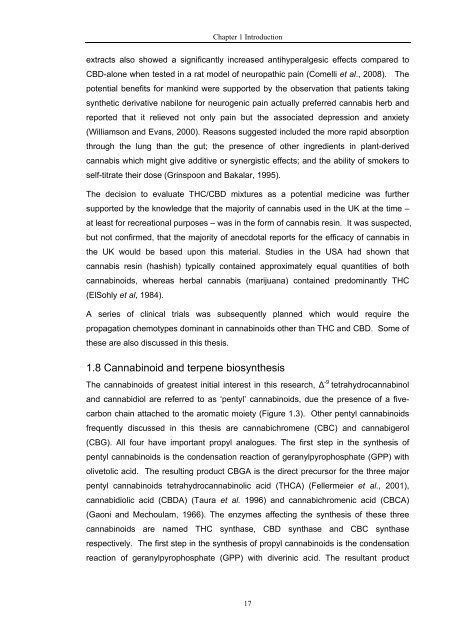finalfullthesisdjpotter
finalfullthesisdjpotter
finalfullthesisdjpotter
You also want an ePaper? Increase the reach of your titles
YUMPU automatically turns print PDFs into web optimized ePapers that Google loves.
Chapter 1 Introduction<br />
extracts also showed a significantly increased antihyperalgesic effects compared to<br />
CBD-alone when tested in a rat model of neuropathic pain (Comelli et al., 2008). The<br />
potential benefits for mankind were supported by the observation that patients taking<br />
synthetic derivative nabilone for neurogenic pain actually preferred cannabis herb and<br />
reported that it relieved not only pain but the associated depression and anxiety<br />
(Williamson and Evans, 2000). Reasons suggested included the more rapid absorption<br />
through the lung than the gut; the presence of other ingredients in plant-derived<br />
cannabis which might give additive or synergistic effects; and the ability of smokers to<br />
self-titrate their dose (Grinspoon and Bakalar, 1995).<br />
The decision to evaluate THC/CBD mixtures as a potential medicine was further<br />
supported by the knowledge that the majority of cannabis used in the UK at the time –<br />
at least for recreational purposes – was in the form of cannabis resin. It was suspected,<br />
but not confirmed, that the majority of anecdotal reports for the efficacy of cannabis in<br />
the UK would be based upon this material. Studies in the USA had shown that<br />
cannabis resin (hashish) typically contained approximately equal quantities of both<br />
cannabinoids, whereas herbal cannabis (marijuana) contained predominantly THC<br />
(ElSohly et al, 1984).<br />
A series of clinical trials was subsequently planned which would require the<br />
propagation chemotypes dominant in cannabinoids other than THC and CBD. Some of<br />
these are also discussed in this thesis.<br />
1.8 Cannabinoid and terpene biosynthesis<br />
The cannabinoids of greatest initial interest in this research, Δ -9 tetrahydrocannabinol<br />
and cannabidiol are referred to as ‘pentyl’ cannabinoids, due the presence of a fivecarbon<br />
chain attached to the aromatic moiety (Figure 1.3). Other pentyl cannabinoids<br />
frequently discussed in this thesis are cannabichromene (CBC) and cannabigerol<br />
(CBG). All four have important propyl analogues. The first step in the synthesis of<br />
pentyl cannabinoids is the condensation reaction of geranylpyrophosphate (GPP) with<br />
olivetolic acid. The resulting product CBGA is the direct precursor for the three major<br />
pentyl cannabinoids tetrahydrocannabinolic acid (THCA) (Fellermeier et al., 2001),<br />
cannabidiolic acid (CBDA) (Taura et al. 1996) and cannabichromenic acid (CBCA)<br />
(Gaoni and Mechoulam, 1966). The enzymes affecting the synthesis of these three<br />
cannabinoids are named THC synthase, CBD synthase and CBC synthase<br />
respectively. The first step in the synthesis of propyl cannabinoids is the condensation<br />
reaction of geranylpyrophosphate (GPP) with diverinic acid. The resultant product<br />
17


